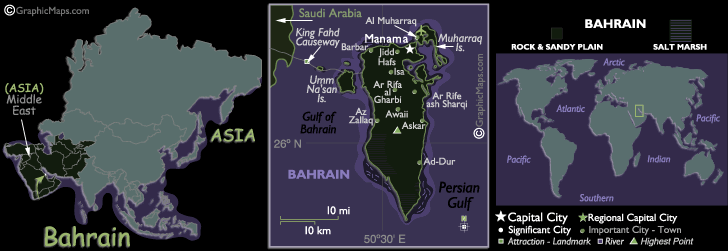
KINGDOM OF BAHRAIN
These notes are available for your viewing pleasure!
Click on the thumbnails to enlarge.

KINGDOM OF BAHRAIN
These notes are available for your viewing
pleasure!
Click on the thumbnails to enlarge.
The history of currency in
Bahrain and the Bahrain Dinar
The Umayyad governors of Bahrain made the first
coins of Bahrain during the eighth century, although for the next thousand
years most coins in use in Bahrain were either imported or locally struch in
imitation of foreign coins. British gold sovereigns and the silver Maria
Theresa Thalers were widely used well into the 1960's even after local
banknotes and coins were long since established. The Indian rupee was the
official currency of Bahrain up until 1959, when it was replaced at a 1:1
ratio by the Gulf rupee issued by the Reserve Bank of India which was
created for use in the Persian Gulf to reduce the drain on India's foreign
currency reserves. The original Indian rupee was divided into 16
Annas but when the Gulf rupee was introduced in was decided to make it
divisible by 100 Naye Paisa. The Gulf rupee notes looked similar to the then
current Indian rupee notes but were different in colour.
India devalued its' currency in 1966 which affected the value of the Gulf
rupee as well, this intern forced countries using the gulf rupee to look for
an alternative or introduce their own currencies. Bahrain chose to introduce
its' own currency in 1965, the Bahraini Dinar which replaced the Gulf rupee
at a rate of 1 Dinar was eqaul to 10 Gulf rupees. The new currency was
divided into 1000 fils.
Bahrain's first banknotes were issued by the Bahrain Currency Board from
1965 until 1973 and from 1973 till present the Bahrain Monetary Agency has
played this role.
Bahrain, and the United Arab Emirates and Qatar had an interchangeability
agreement for banknotes starting in January 1978. The rates of interchange
were 10 Qatari riyals = 1 Bahrain dinar = 10 United Arab Emirates dinars, up
to 5,000 Qatari riyals, 500 Bahrain dinars, or 5,000 United Arab Emirates
dinars. The agreement fell apart in May 1979 after Qatar revalued its
currency.
Banknotes in Bahrain currently in circulation come in denominations of 1/2
Diner or 500 fils, 1 Dinar, 5 Dinars, 10 Dinars and 20 Dinars. Coins come in
denominations of 500 fils, 100 fils, 50 fils, 25 fils and 10 fils.
The Bahraini Dinar is locally written as BD and prices are normally written
to three decimal places as the currency is divided into 1000. Bahrain's
currency ISO code is BHD. The Bahrain Dinar is currently the third
most valuable currency unit in the world after the Kuwaiti Dinar and the
Maltese Lira.
The unauthorized second
printing of the Bahraini 20 Dinar banknote
A group of confidence men passing themselves to be representatives of the
Bahrain Monetary Agency
illegally ordered these 20 Dinar notes from the Argentinian security printer
Ciccone Calcografica. More then 75,000 of these fake 20 Dinar of 1.5 million
Dinars worth of the dubious notes were presented for payment at various branches
of the Bahrain Monetary Agency in the United Arab Emirates from 4 to 11 June
1998. At this time the notes were discovered to be slightly different from
the notes currently in circulation. The Bahrain Monetary Agency imeadiatly
contacted their printer Thomas de la Rue in London to find out if there had been
any changes to the plates used to print the 20 Dinar notes, which of course
Thomas de la Rue said there were none. The genuine 20 Dinar notes were
consequently withdrawn from circulation on 30 July 1998. The Bahrain
promptly replaced the purple 20 Dinar note with a peach coloured version of the
same design.


The Argintinian notes can be distinguished from the originals by the spacing
between the first two Arabic letters of the horizontal serial number found in
the bottom right of the front of the note and by the difference in shading in
the panel behind the name in Arabic of the Bahrain Monetary Agency on the front.
BACK TO HOMEPAGE
Page created: 6 June 2006
Last Update: 12 June 2006
Maps are provided by Graphic Maps
All maps provided by them bear their copyright information.
All scans shown here are of actual notes from my collection unless otherwise
noted.
Images and content unless otherwise noted are copyrighted.
(c) 2006 Will's Online World Paper Money Gallery